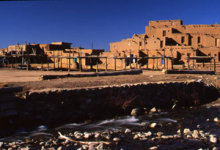Article
A Native American building form found along the Rio Grande in New Mexico and west as far as the Hopi mesas in Arizona. Pueblos are clustered, modular structures traditionally built of adobe, although pueblo buildings in more arid areas, like Chaco Canyon, have been built of unfinished sandstone blocks. Pueblo architecture is a fundamental synthesis of spiritual, social, and material sustainability. The block-like rooms, constructed of local materials, are typically built around one or more communal spaces called plazas, and are often terraced in rising and receding stories that create an open-air amphitheater around the plaza below. Although the interior spaces of pueblo structures are functional, they serve more as storage space rather than living space, because most traditional activities occur in the plaza or on the terraced patios created by the stepped nature of pueblos' aggregated stories. Few windows or doors penetrate load-bearing walls, so ventilation and access occurs through the ceilings into the rooms below. Descending into the darkened and enclosed space of a pueblo interior from the ceiling above is an enactment of returning to the womb and sacred space of Mother Earth, while climbing up out of these spaces functions as a reenactment of the Pueblo peoples' birth, or emergence, into the current world from the underworld.
Although contact with Europeans over the past five centuries has altered superficial elements of the pueblo building style, including its romanticized appropriation in the Spanish Pueblo Revival style popularized by U.S. architects during the 1920s and '30s, pueblos retain much of the same functionality and significance today as they did to the Pueblo communities who lived in them prior to European contact. Several pueblos have been continuously inhabited for thousands of years, which speaks to the resiliency of pueblo architecture as both a building form and as a social and spiritual practice.
"Taos Pueblo, 1995," photograph by Eduardo Fuss. Eduardo Fuss Photograph Collection (2011-001-b34-f04-0004). Center for Southwest Research, University of New Mexico.

